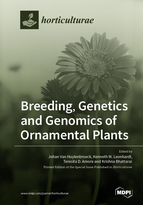Breeding, Genetics and Genomics of Ornamental Plants
A special issue of Horticulturae (ISSN 2311-7524). This special issue belongs to the section "Genetics, Genomics, Breeding, and Biotechnology (G2B2)".
Deadline for manuscript submissions: closed (20 September 2021) | Viewed by 19120
Special Issue Editors
Interests: interspecific breeding, protoplasts; ploidy manipulation; disease resistance breeding; genetics and breeding of ornamentals
Interests: variety development in tropical ornamental plants, including warm temperature tolerant proteas and converting prolific seed producing landscapes ornamentals to sterile forms through traditional breeding and polyploid induction. Such species and hybrids have no potential to become invasive.
Interests: Breeding and genetics of orchids and anthurium; germplasm; tissue culture; floricultural arts
Special Issue Information
Dear Colleagues,
Ornamental crops account for more than US $42 billion globally. With the exception of few floral species, limited genetic, genomic, and breeding information is publicly available, owing to the fact that the majority of breeding work is performed by the private sector. Public research programs are increasingly participating in ornamental cultivar development and genetic studies. With lower sequencing costs, genomic information of non-model species including ornamental crops is continuously becoming available.
Ornamental breeding utilizes a wide array of breeding strategies ranging from traditional crossing and selection methods to the use of next-generation sequencing in genomics and transcriptomics for gene identification and trait development. A continuing search of new species for the ornamentals industry has resulted in the utilization of tools that increase diversity and in the development of alternative methods for obtaining new crops by achieving interspecific and intergeneric crosses.
In this Special Issue, we aim to present papers on new breeding methods, novel cultivars and species entering the ornamental industry, the identification of genes conferring novel traits, technological developments in ornamentals research, and the use of next-generation sequencing to improve ornamental plants.
Dr. Johan Van Huylenbroeck
Dr. Kenneth W. Leonhardt
Dr. Teresita D. Amore
Dr. Krishna Bhattarai
Guest Editors
Manuscript Submission Information
Manuscripts should be submitted online at www.mdpi.com by registering and logging in to this website. Once you are registered, click here to go to the submission form. Manuscripts can be submitted until the deadline. All submissions that pass pre-check are peer-reviewed. Accepted papers will be published continuously in the journal (as soon as accepted) and will be listed together on the special issue website. Research articles, review articles as well as short communications are invited. For planned papers, a title and short abstract (about 100 words) can be sent to the Editorial Office for announcement on this website.
Submitted manuscripts should not have been published previously, nor be under consideration for publication elsewhere (except conference proceedings papers). All manuscripts are thoroughly refereed through a single-blind peer-review process. A guide for authors and other relevant information for submission of manuscripts is available on the Instructions for Authors page. Horticulturae is an international peer-reviewed open access monthly journal published by MDPI.
Please visit the Instructions for Authors page before submitting a manuscript. The Article Processing Charge (APC) for publication in this open access journal is 2200 CHF (Swiss Francs). Submitted papers should be well formatted and use good English. Authors may use MDPI's English editing service prior to publication or during author revisions.
Keywords
- Landscape Plants
- Flowers
- Cutflowers
- Annuals and Perennial Flowers
- Genetic Linkage Map
- QTL Mapping
- Fine Mapping and Gene Identification
- Cultivar Development
- Disease Resistance Breeding
- Transcriptome Sequencing
- Differential Gene Expression
- Genome Sequencing and Characterization
- Abiotic Stress Tolerance
- Ploidy Manipulation
- Mutation Breeding
- Somaclonal Variation
- Cytogenetics
- Apomixis







